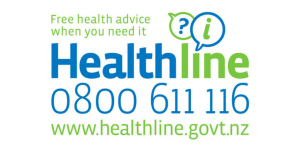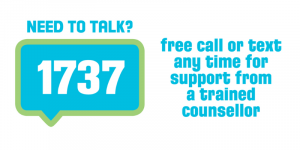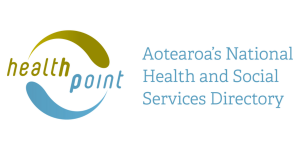Wishing everyone happy holidays and a joyful New Year from the Healthify team. Don't forget to Slip, Slop, Slap and Wrap!
Oestrogen for gender affirming hormone therapy
Key points about oestrogen for gender affirming hormone therapy (GAHT)
- Oestrogen can be used as part of gender affirming hormone therapy (GAHT).
- Oestrogen is available in different forms such as tablets or as patches or gel that you apply to your skin.
- An anti-androgen medication is needed alongside oestrogen for GAHT unless you have had an orchiectomy.
- Find out more about oestrogen for GAHT.

Oestrogen based gender affirming hormone therapy (E-GAHT) is used by some transgender and non-binary people to help align their body with their gender. E-GAHT can be used by trans women or non-binary people for gender feminising effects such as breast development, softer skin and reduced oiliness, body fat redistribution and decreased muscle mass and strength.
- E-GAHT is 2 types of medicines – a form of oestrogen (patches, gel or tablets) and a medicine to block testosterone (an anti-androgen).
- Both are needed unless you've had an orchiectomy (surgical removal of your testicles), in which case the anti-androgen isn't needed.
Oestrogen is available in different forms such tablets, patches or gel
Your healthcare provider will discuss which form of oestrogen is recommended for you based on your individual health history. There's no difference in feminising effects between the different types but there are different risks to consider. Not all options are suitable for everyone. For example, the patches and gel which are applied to the skin, have a lower risk of causing blood clots compared to the tablets. Read more about oestrogen patches, gel and tablets below.
To make sure E-GAHT is safe for you, tell your healthcare provider if you:
- have ever had any type of cancer
- have ever had a blood clot in a vein (thrombosis), such as in your legs (deep vein thrombosis) or lungs (pulmonary embolism)
- have ever had angina or a heart attack
- have thrombophilia, a condition that increases the risk of blood clots
- have liver problems
- have migraines or severe headaches.
Oestrogen patches are applied to the skin and slowly release the hormone oestradiol. The hormone from the patch is absorbed through your skin and into your body.
Oestrogen patches come in different brands and strengths
- In Aotearoa New Zealand examples of oestrogen patches include Estradiol (Sandoz® and Mylan/Viatris®), Estradot®, Estraderm MX® and Lyllana Estradiol®.
- Oestrogen patches are available in different strengths. Your healthcare provider will advise you on the best dose for you.
- The patches are usually applied twice a week, every 3 or 4 days.
- Pharmac currently funds 2 patches per week. This can mean that at higher doses not all the patches will be funded. You can discuss this with your healthcare provider.
Pros and cons of oestrogen patches
- Pros: Oestrogen patches are convenient because they only need to be applied twice a week and you don't have to remember to take a tablet every day. The risk of some side effects, such as blood clots, is lower with patches than with oestrogen tablets.
- Cons: The patch works well for many people, but it may not be a suitable option if you swim frequently, sweat profusely, or soak in hot tubs and baths. Also, the patch itself might irritate the skin where you apply it.
Cutting patches
Ideally, patches shouldn't be cut but, due to supply issues and shortages, it's sometimes necessary to cut them. Your pharmacist will tell you if your patch can be cut and if the rest of the patch can be used later. Here is some guidance when cutting patches:
- Cut the patch diagonally from corner to corner. For round patches, fold in half and cut along the folded line.
- If the other half can be used for the next dose, store it in an airtight plastic bag at room temperature for up to 1 month.
Other tips
- Remove an old patch before applying a new patch. Make sure your skin is clean and dry. Don't apply the patch to oily, broken or irritated skin.
- When applying the new patch, press the patch firmly in place for about 10 seconds. Make sure the patch sticks well, especially around the edges. Don't put the patch on the same area of skin for the next few applications.
- Some procedures such as an MRI scan may overheat the patch and burn your skin. Talk to your healthcare provider before your procedure.
- Avoid lotions or perfumes on areas where you stick your patch as it may stop the patch from sticking properly.
- Read more about the safe use of medicine patches.
In Aotearoa New Zealand, oestrogen is available as a gel that's applied to your skin. It's called Estrogel® and is available in the 0.06% strength
- Estrogel comes in a container with a metered dose pump, which means that each pump gives the same amount of gel and the same dose.
- One pump gives 1.25 g of gel containing 0.75 mg of oestradiol.
Dose
- The usual dose is 1 or 2 pumps, as recommended by your healthcare provider. Apply the gel once daily in the morning or evening, at about the same time each day.
- Your healthcare provider may adjust your dose, depending on your response to treatment, up to a maximum of 4 pumps in 24 hours.
- If you forget to apply a dose and it is more than 12 hours until your next dose, apply it as soon as you remember.
- If it's less than 12 hours until your next dose, then skip the missed dose and apply the next dose at the usual time. Don't apply a double dose to make up for a forgotten dose.
- Learn more about how to apply Estrogel.
Pros and cons of oestrogen gel
- Pros: The risk of some side effects, such as blood clots, is lower with the gel than with oestrogen tablets. The gel must be applied consistently every day but it's quick to apply and dries relatively fast.
- Cons: Oestrogen may be transferred to other people through skin-to-skin contact where you applied the gel. To avoid transfer to others, it's important to wash your hands straight after applying the gel and put on clothing over the area once the gel has dried on your skin. For the gel to work well, you must wait at least 1 hour after gel application before you have a bath, shower or swim.
In Aotearoa New Zealand oestradiol valerate (called Progynova) is used for E-GAHT. The tablets are available in 2 strengths –1 mg and 2 mg. Your healthcare provider will advise you on the best dose for you. They will usually start you on a low dose (1 or 2 mg daily) and increase your dose gradually, to a maximum of 4 to 6 mg daily.
Pros and cons of oestrogen tablets
- Pros: They may be suitable for people with sensitive skin where the patch or gel may not be suitable.
- Cons: The risk of some side effects, such as blood clots, is higher with oestrogen tablets.
Anti-androgen medicines are used alongside oestrogen for gender affirming hormone therapy by some transgender and non-binary people to help align their body with their gender. This combination is needed unless you've had an orchiectomy (surgical removal of your testicles), in which case the anti-androgen isn't needed.
Examples of anti-androgen medicines
In Aotearoa New Zealand spironolactone tablets or cyproterone tablets are commonly used.
- Spironolactone works by blocking the effects of testosterone in your body, eg, by promoting breast growth and slowing down body hair. Spironolactone can change blood potassium levels so blood test monitoring is important, especially if you have kidney problems. Read more about spironolactone.
- Cyproterone works by stopping the release of testosterone. Cyproterone can cause side effects including tiredness (fatigue), low mood, weight changes, problems with your liver, blood clots and meningioma (a non-cancerous brain tumour), so you should discuss this with a medical professional and use the lowest effective dose. Read more about cyproterone.
Some people may use an injected implant called goserelin. Goserelin implant is inserted into lower abdomen every 12 weeks.
Your healthcare provider will arrange for you to have blood tests before you start treatment and during your treatment, usually 3 to 6 monthly for the first year and 6 to 12 monthly from then on (or as agreed with your healthcare provider). This is to check your liver function and cholesterol levels, as well as monitoring hormone levels. You’ll usually need to have your blood pressure and weight checked once a year.
Oestrogen levels are only monitored to make sure they're not too high, as high levels could be a health risk. Oestrogen levels don’t strongly relate to physical changes or how satisfied people feel, and there’s not enough evidence to support aiming for a specific target range. Instead, your dose will be adjusted based on typical dosing guidelines and how you're experiencing the effects.
E-GAHT can lead to gradual changes over many months and years. There are some things it can't change (see below). Effects vary for different people.
Permanent changes
- Breast growth: This is gradual over 2 to 3 years. Breasts can vary in size and shape, between people. Most people starting oestrogen-based hormone therapy after puberty can expect to develop an A cup or smaller.
- Shrinking of your testes.
- Infertility: With time, your testicles may get smaller and stop making sperm, which could mean you won't be able to have biological children in the future. Talk to your healthcare provider about the option of storing sperm before you start E-GAHT.
The following changes are not permanent
These changes will slowly reverse if you stop taking hormones.
- Skin softening.
- Reduced muscle mass and strength.
- Slower hair growth on body and face (but it doesn't stop completely).
- Body fat redistribution (more on hips, bottom, thighs).
E-GAHT does NOT change the following
- Voice (your healthcare provider may be able to refer you for voice therapy).
- Bone structure.
- Adams apple.
- Hair growth doesn't stop completely (some people use laser hair removal).
Note: Contraception should still be used if you're having sex which could result in pregnancy.
You may hear about people using progesterone as part of E-GAHT, but currently there's no good quality evidence for the benefit of using this as part of GAHT. There are also associated risks, so it's not generally recommended.
Common side effects
- Breast tenderness and weight gain.
- Nausea and headaches can occur when starting oestrogen and usually settle in the first few days or weeks. Tell your healthcare provider if you develop migraines.
Other risks
The risk of health problems is higher if you smoke or are overweight or are over the age of 45 years.
- There is a small increased risk of liver problems and raised cholesterol (these are both monitored on the blood tests).
- There is an increased risk of blood clots. Using oestrogen patches instead of tablets reduces this risk. Get immediate medical advice if you get pain, redness or swelling in one of your legs, usually in your calf. This could be a sign of deep vein thrombosis (DVT), a common sign of blood clots. There is a risk of a blood clot travelling to your lungs, so seek urgent medical advice if you experience shortness of breath or chest pain.
- There may be a slight increased risk of breast cancer compared with cisgender men.
Transgender New Zealanders(external link) Health New Zealand | Te Whatu Ora
Transgender fertility(external link) Fertility Associates
Brochures
Oestrogen-based gender affirming hormone therapy(external link) Primary Care Gender Affirming Hormone Therapy Initiation Guidelines, NZ, 2023
Preserving sperm(external link) Fertility Associates
Medicines and side effects [PDF, 91 KB] Healthify He Puna Waiora, NZ, 2024
References
- Carroll R, Nicholls R, Carroll RW, et al. Primary care gender affirming hormone therapy (GAHT) initiation guidelines(external link) NZ, 2023
- Oliphant J, Veale J, Macdonald J, et al. Guidelines for gender affirming healthcare for gender diverse and transgender children, young people and adults in Aotearoa, New Zealand(external link) Transgender Health Research Lab, University of Waikato, NZ, 2018
Brochures
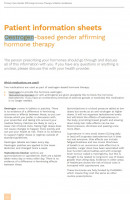
Oestrogen-based gender affirming hormone therapy
Primary Care Gender Affirming Hormone Therapy Initiation Guidelines, NZ, 2023
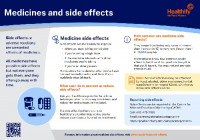
Medicines and side effects
Healthify He Puna Waiora, NZ, 2024
Credits: Healthify editorial team. Healthify is brought to you by Health Navigator Charitable Trust.
Reviewed by: Dr Rona Carroll, FRNZCGP, PGDip, Wellington
Last reviewed:


